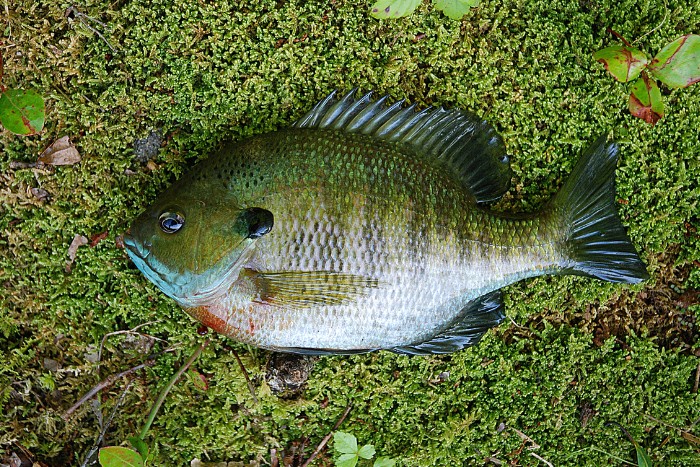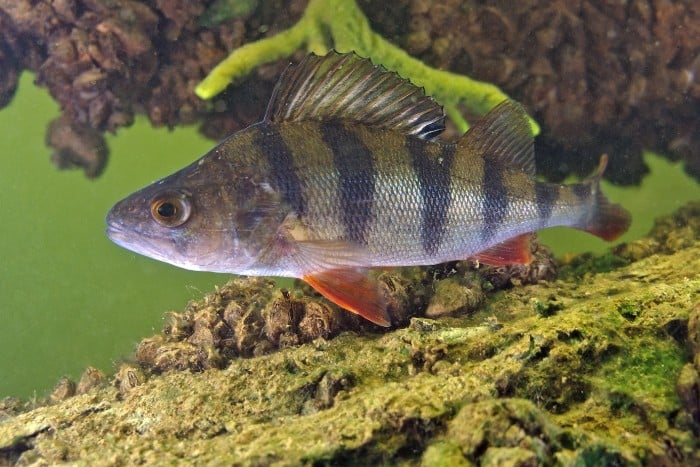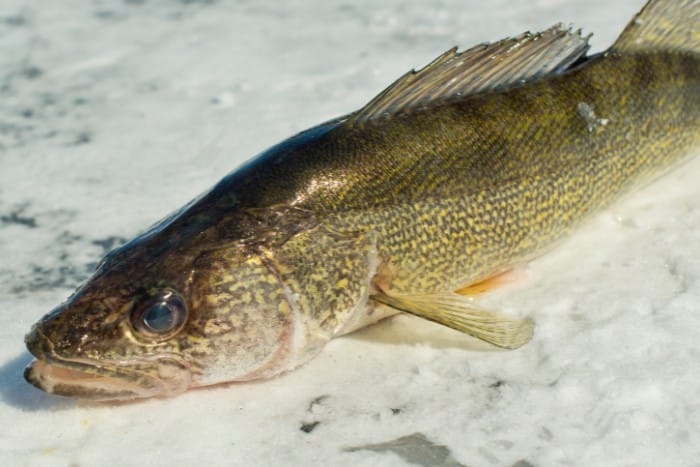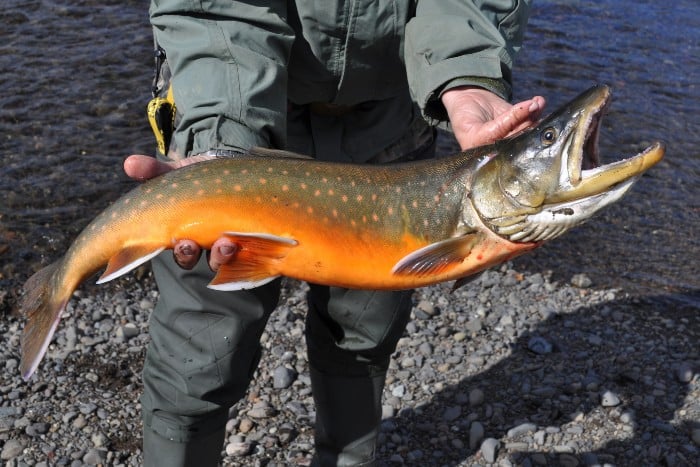Ice fishing was once a way of life for indigenous people across North America and is now a popular pastime for anglers willing to brave the cold. Just because the top few inches of a lake are frozen does not mean that the fish underneath are inactive.
When ice fishing, you may be surprised to learn that you can fish for many different species. Any fish in a body of water that freezes over still needs to survive winter. Popular targeted species include bluegill, perch, bass, walleye, trout, bass, muskies, and many other species in cold climates.
Read on to learn more about the different fish species you might encounter when ice fishing and why people fish them.
Popular Ice Fishing Species Across North America
The species below are all popular ice-fishing options across the United States and Canada, where ice-fishing is a popular winter activity.
While not exhaustive, the fish on this list will cover the most commonly targeted species and a few you may have never heard of before.
Some of these species are invasive or were introduced by settlers, and many others are native to those areas and were an essential part of early life here.
While ice fishing has changed a lot in that time, it is important to remember its roots.
1. Bluegill
Bluegill are abundant, incredibly easy to catch, and tasty. Plus, if you don’t want to eat them, you can use them as bait for bigger fish!
Bluegill is one of the most commonly caught fish for fun summer fishing, but they are still highly sought-after fish to catch during the winter.
Catching bluegill is easy, and they are very receptive to small baits or micro jigs. Target an area 15-30 feet deep with a soft bottom, as this is where bluegill school eats larvae during winter.
Mimicking the natural food sources with live larvae or a small 1/64-ounce tungsten jig will work well.
If you are looking for large bluegill to filet and sear up for eating, upgrade to minnow heads and a 1/8 or 1/4 -ounce jig, which will result in fewer but higher quality bites.

2. Crappie
Crappie is another popular ice-fishing species, perfect for eating while still providing a fun fight to reel them in.
There are two main crappie species, black and white, but both are similar in taste and how to catch them.
Crappie grows a bit larger than bluegill, making them an even better species for the dinner plate. Catching them is the same as bluegill, with light tackle and jigging or using live bait working well.
Pound for pound, crappie are one of the hardest fighting fish, and even during winter, when the fish are less active, you’ll still have a blast reeling in a giant crappie.
And in the end, any crappie that you keep will taste delicious.
3. Other Sunfish Species
Centrarchidae, more commonly referred to as sunfish, is a large family of freshwater fish native to North America and includes bass, bluegill, and crappie.
The family of fish consists of 34 species, and most of them are popular for sport fishing. These other fish include pumpkinseed, green sunfish, and mud sunfish, to name a few.
Make sure to check local laws before harvesting any fish, as some may be protected, but for the most part, most sunfish are fair game and excellent eating.
Targeting these fish is the same as ice fishing for other small species, using small live bait, cut bait, and small jigs.
Many sunfish species look similar to one another, so be sure to research which ones are living in your area!
4. Perch
Perch is a general term for the genus Perca, made up of three species, each found in different geographic regions.
In North America, there is the yellow perch, the Balkhash perch found in central Asia, and the European perch in Europe.
Perch is closely related to another fish on this list, the walleye, one of the most popular ice-fishing targets. Perch meat is flaky, white, and sweet, making it another great-tasting choice.
Perch meat is also full of nutritional benefits, making it one of the healthiest choices.
Perch hang out in shallow water near vegetation in early winter and will migrate deeper as winter goes on.
They primarily rely on an insect diet, so if you are targeting this species, you can use waxworms on a jig or plastic waxies if you want a live-bait-free option.

5. Pike
Pike is a widely loved species to catch ice fishing and is much larger than most other fish on this list, meaning any small fish you catch can be great bait for pike.
Not only can pike grow 2+ feet in length, but they are comfortable in cold water, making them aggressive and fun to catch.
Pike have sharp teeth, so many anglers have used wire leaders to prevent break-offs, although other anglers find they get more bites when not using wire.
Whichever method you choose, be sure to use larger lures or whole minnows, live or frozen. Pike are aggressive hunters, so you can match that with aggressive jigging techniques.
6. Trout
Trout is another active winter fish that will happily feed in cold water and is better adapted to cold water than warm water.
Since trout are such active fish during winter, live bait is your best option for catching them. 1/64 to 1/8-ounce jigs with small minnows or wax worms work perfectly for catching trout.
Trout like to hang out in shallow water during winter, so start searching for them where the shallow water begins to transition to the deeper water; this will vary based on the lake you’re fishing.
7. Walleye
Walleye are one of the most widely treasured fish to catch when ice-fishing in North America, thanks to their large size and aggressive behavior.
Walleyes can be caught in the 30-36” range, resulting in a great fish to catch on ice fishing gear.
Walleye can be difficult to catch as they are active in all water depths and focus on eating only one large meal rather than several small meals throughout the day.
If you want to catch a large walleye, you’ll need to use large bait and appropriate gear. Eating walleye, you’ll experience mild flavors and excellent flaky meat.
Compared to other fish on this list, their tastes aren’t unique, but they are a fun sport fish.

8. Largemouth, Smallmouth, And Rock Bass
Bass fishing is the largest market for freshwater fishing, and while people typically see bass fishing as a summer activity, they are still voracious eaters during winter.
Ice-fishing for bass requires a slower, more methodical approach than some standard bass fishing methods.
If you are a bass fisherman used to striking hard and fast and looking to try ice fishing for them, you’ll need to be much more patient during winter.
Bass are much less active in cold water and will cautiously approach bait.
Catching bass during winter has an added layer of difficulty because they won’t travel in schools, opting to hunt alone near the bottom of the lake or pond.
You’ll need to be patient and keep fishing deep in the water to catch one.
9. Muskellunge
Muskellunge, more commonly Muskies, are prehistoric-looking apex predators only threatened by large birds and people.
These fish reproduce slowly and have been subject to overfishing, so some areas require catch and release for this species.
Muskies are not only awesome-looking fish, but they are challenging to catch. If you want to catch a musky, you’ll need patience and a bit of luck.
Many anglers report a better chance of catching these fish on waxworms than larger baits, but muskies will eat anything.
10. Burbot
Ice fishing for burbot might satisfy that itch if you have ever wanted to catch an eel in freshwater during the winter.
Not only are these fish active during winter, but they require these cold temperatures to breed.
Burbot are native to the northern states and throughout Canada, and these fish are common, often competing with other predator species.
Check local laws, but most areas prefer you keep burbot rather than release them to impact other species positively.
Fishing for these guys is best done with minnow or minnow head on a large spoon, and the fluttering will attract burbot from a distance, while the bait will ensure a strike.
Burbots are such voracious predators that you’re likely to get a bite as long as you are near one.
11. Salmon
Landlocked salmon are salmon trapped in large bodies of water, unlike most salmon that migrate into the ocean.
The bodies of water they reside in are typically large lakes, and salmon stay in water up to 80 feet deep during winter.
Choose a bait native to the body of water you’re fishing for the best results, as landlocked salmon are typically uninterested in lures.
The exception is Kokanee salmon, where small colorful spoons are a viable lure.
If you are fishing for salmon, placing several tip-ups at various depths is recommended since salmon can cover a wide area, and the more area you are fishing, the better.

12. Catfish
Catfish might not be the first species that you think of for ice fishing, but catching catfish during the winter is better than you might think.
Channel catfish are the most commonly caught and are aggressive winter feeders.
Channel cats also prefer to stay in groups during winter, meaning that when you catch one, the action can be quick, resulting in several more catches in a brief period.
Both cut bait and live bait will produce catfish, and some anglers will even catch them on spoons and jigs when targeting other fish.
13. Sheefish
Sheefish are native to the northernmost rivers and lakes of Canada, Alaska, and Russia. While not as popular to catch as other species on this list, the sheefish is a large fish important for the people up north.
Sheefish fishing requires drilling through up to four feet of ice and they can weigh up to 60 pounds. One good catch can last several days and is vital to gathering food in cold, remote areas.
You can catch sheefish on lures or live bait, and native populations commonly use handmade lures. These fish are related to salmon but do not die after spawning resulting in large adult sheefish being common.
14. Arctic Char
Arctic char is the most northern freshwater fish and is the only species of fish found in Lake Hazen in the Canadian Arctic.
Dwarf and giant varieties exist, ranging in size from seven ounces to ten pounds. Full-grown giants are twice the size of full-grown dwarf varieties.
Not only is Arctic char an interesting species biologically, but it is also a sustainable choice for consumers, with commercial operations becoming increasingly common.
You’ll have to travel to cold locations for ice fishing, but the payoff is worth it. The best lure for these fish is a 2-inch orange spoon, fished aggressively.
Fast jigging of the lure will create enough flash and vibration to attract the char to come to bite. Twenty feet deep is the best depth to catch these fish in open bottom areas.

15. Smelt
Smelt are small fish, only 6-8 inches long and weighing a few ounces. These fish are so small that they are often too small to get hooked, and many anglers find them just holding on to the bait.
Smelt do not put up much of a fight, even accounting for their small size. What they lack in size, they make up for in numbers, making it possible to hit your limit in a couple of hours.
From there, you can use them as bait for other fish or cook and clean them yourself.
The most common way people consume smelt is by gutting them and then grilling and eating them whole. If you have access to smelt this winter, try catching them, and you’ll be surprised at how easy it is!
16. And Many Others!
For as many freshwater fish as there are, any of them that live in bodies of water where you can ice fish, you can catch them.
The most common species caught are those native to Alaska and the Midwest, where ice fishing is the most popular, but you can catch plenty of unique species anywhere there is ice fishing.
Sturgeon, for example, is not a commonly caught ice fishing species, but when you catch one, you might need to drill extra holes in the ice to get it out.
Whitefish are another family of fish that offers several great ice-fishing species. Sometimes when ice fishing, you can catch some non-fish animals, with muskrats being a popular accidental catch.
Mudpuppies are another species that anglers often catch by mistake when fishing for something else.
Wrapping Up!
So there you have it, 16 species of fish to target when ice fishing and a bit of background on each one, which should give you a good idea of what is available to catch, even in the middle of winter.
Remember to stay warm, stay safe, and minimize your impact on the environment around you. This way, you and the people who fish after you can all have the same enjoyable experience.
